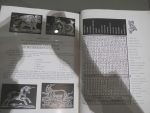Some parts of the miniseries “Unorthodox” about the woman who escaped from a Hassidic sect in Brookyln were filmed a block away from me, namely, the apartment building where her fictional mother lives. Incidentally it was designed by a maddening architect – occasionally good, often aggressively lousy – named Hinrich Baller who was one of Berlin’s most popular from the 1980s to 2000s. He tried to bring some human-ness, life, and insipiration from nature to the unyielding, cold and ruthlessly functional watered-down Bauhaus that has steamrolled over Germany since 1950. Emphasis on tried.
Occasionally he hit the mark but very often got derailed into awkward geometric shapes forced into screeching juxtapositions, an obsession with unnecessarily sharp pointy angles verging on the pathological, zero sense of proportion and oh my goodness the railings. So. Many. Railings. Explosions of thin metal rods bent into ugly forms with lots of gaps and protrusions for entangling limbs, shoulder bags, and children’s heads.
Next to the apartment building is a school he designed which a Berlin newspaper called a “chronicle of scandals”: construction took eight years, leaving a trail of bankrupt companies and water leaks and a bill almost twice what was budgeted. However this is normal for Berlin so it wouldn’t be fair to blame him alone. But alll that was years before they had any idea a wing would have to be completely shut down and barricaded in 2017 after less than 20 years of use, due to deterioration, holes in the walkways big enough for a child to fall into, lack of fire exits, and still more leaks, forcing the students to eat lunch in their classrooms and the cancellation of German-language classes for immigrants. The school is in one of the city’s most desirable and prosperous neighborhoods, by the way, but still the area has so much violence the school has to have armed guards. So you can imagine what things are like in the city’s underserved communities.
Anyway… that all has nothing to do with the Unorthodox show. Here are photos showing the parts that were filmed just down the street from me. Click on the photos to enlarge. In each pair, the one on the left is a screenshot from the show and the one on the right is a photo I took myself. These are all scenes from when the woman goes to visit her mother.
 Continue reading ““Unorthodox” miniseries, also, bad architecture”
Continue reading ““Unorthodox” miniseries, also, bad architecture”
















